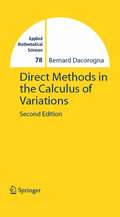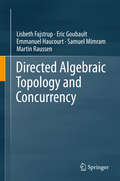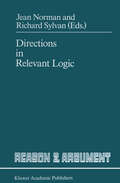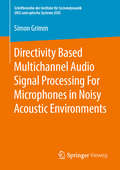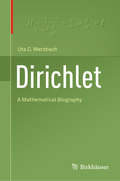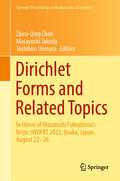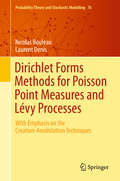- Table View
- List View
Direct Methods for Sparse Matrices (Numerical Mathematics and Scientific Computation)
by I. S. Duff A. M. Erisman J. K. ReidThe subject of sparse matrices has its root in such diverse fields as management science, power systems analysis, surveying, circuit theory, and structural analysis. Efficient use of sparsity is a key to solving large problems in many fields. This second edition is a complete rewrite of the first edition published 30 years ago. Much has changed since that time. Problems have grown greatly in size and complexity; nearly all examples in the first edition were of order less than 5,000 in the first edition, and are often more than a million in the second edition. Computer architectures are now much more complex, requiring new ways of adapting algorithms to parallel environments with memory hierarchies. Because the area is such an important one to all of computational science and engineering, a huge amount of research has been done in the last 30 years, some of it by the authors themselves. This new research is integrated into the text with a clear explanation of the underlying mathematics and algorithms. New research that is described includes new techniques for scaling and error control, new orderings, new combinatorial techniques for partitioning both symmetric and unsymmetric problems, and a detailed description of the multifrontal approach to solving systems that was pioneered by the research of the authors and colleagues. This includes a discussion of techniques for exploiting parallel architectures and new work for indefinite and unsymmetric systems.
Direct Methods in Control Problems
by Peter FalbVarious general techniques have been developed for control and systems problems, many of which involve indirect methods. Because these indirect methods are not always effective, alternative approaches using direct methods are of particular interest and relevance given the advances of computing in recent years.The focus of this book, unique in the literature, is on direct methods, which are concerned with finding actual solutions to problems in control and systems, often algorithmic in nature. Throughout the work, deterministic and stochastic problems are examined from a unified perspective and with considerable rigor. Emphasis is placed on the theoretical basis of the methods and their potential utility in a broad range of control and systems problems.The book is an excellent reference for graduate students, researchers, applied mathematicians, and control engineers and may be used as a textbook for a graduate course or seminar on direct methods in control.
Direct Methods in the Calculus of Variations (Applied Mathematical Sciences #78)
by Bernard DacorognaThis book is developed for the study of vectorial problems in the calculus of variations. The subject is a very active one and almost half of the book consists of new material. This is a new edition of the earlier book published in 1989 and it is suitable for graduate students. The book has been updated with some new material and examples added. Applications are included.
Direct Methods in the Calculus of Variations (Applied Mathematical Sciences #78)
by Bernard DacorognaIn recent years there has been a considerable renewal of interest in the clas sical problems of the calculus of variations, both from the point of view of mathematics and of applications. Some of the most powerful tools for proving existence of minima for such problems are known as direct methods. They are often the only available ones, particularly for vectorial problems. It is the aim of this book to present them. These methods were introduced by Tonelli, following earlier work of Hilbert and Lebesgue. Although there are excellent books on calculus of variations and on direct methods, there are recent important developments which cannot be found in these books; in particular, those dealing with vector valued functions and relaxation of non convex problems. These two last ones are important in appli cations to nonlinear elasticity, optimal design . . . . In these fields the variational methods are particularly effective. Part of the mathematical developments and of the renewal of interest in these methods finds its motivations in nonlinear elasticity. Moreover, one of the recent important contributions to nonlinear analysis has been the study of the behaviour of nonlinear functionals un der various types of convergence, particularly the weak convergence. Two well studied theories have now been developed, namely f-convergence and compen sated compactness. They both include as a particular case the direct methods of the calculus of variations, but they are also, both, inspired and have as main examples these direct methods.
Direct Methods in the Theory of Elliptic Equations (Springer Monographs in Mathematics)
by Jindrich NecasNečas’ book Direct Methods in the Theory of Elliptic Equations, published 1967 in French, has become a standard reference for the mathematical theory of linear elliptic equations and systems. This English edition, translated by G. Tronel and A. Kufner, presents Nečas’ work essentially in the form it was published in 1967. It gives a timeless and in some sense definitive treatment of a number issues in variational methods for elliptic systems and higher order equations. The text is recommended to graduate students of partial differential equations, postdoctoral associates in Analysis, and scientists working with linear elliptic systems. In fact, any researcher using the theory of elliptic systems will benefit from having the book in his library.The volume gives a self-contained presentation of the elliptic theory based on the "direct method", also known as the variational method. Due to its universality and close connections to numerical approximations, the variational method has become one of the most important approaches to the elliptic theory. The method does not rely on the maximum principle or other special properties of the scalar second order elliptic equations, and it is ideally suited for handling systems of equations of arbitrary order. The prototypical examples of equations covered by the theory are, in addition to the standard Laplace equation, Lame’s system of linear elasticity and the biharmonic equation (both with variable coefficients, of course). General ellipticity conditions are discussed and most of the natural boundary condition is covered. The necessary foundations of the function space theory are explained along the way, in an arguably optimal manner. The standard boundary regularity requirement on the domains is the Lipschitz continuity of the boundary, which "when going beyond the scalar equations of second order" turns out to be a very natural class. These choices reflect the author's opinion that the Lame system and the biharmonic equations are just as important as the Laplace equation, and that the class of the domains with the Lipschitz continuous boundary (as opposed to smooth domains) is the most natural class of domains to consider in connection with these equations and their applications.
Directed Algebraic Topology and Concurrency (SpringerBriefs in Applied Sciences and Technology)
by Lisbeth Fajstrup Eric Goubault Emmanuel Haucourt Samuel Mimram Martin RaussenThis monograph presents an application of concepts and methods from algebraic topology to models of concurrent processes in computer science and their analysis.Taking well-known discrete models for concurrent processes in resource management as a point of departure, the book goes on to refine combinatorial and topological models. In the process, it develops tools and invariants for the new discipline directed algebraic topology, which is driven by fundamental research interests as well as by applications, primarily in the static analysis of concurrent programs.The state space of a concurrent program is described as a higher-dimensional space, the topology of which encodes the essential properties of the system. In order to analyse all possible executions in the state space, more than “just” the topological properties have to be considered: Execution paths need to respect a partial order given by the time flow. As a result, tools and concepts from topology have to be extended to take privileged directions into account.The target audience for this book consists of graduate students, researchers and practitioners in the field, mathematicians and computer scientists alike.
Directed Polymers in Random Environments: École d'Été de Probabilités de Saint-Flour XLVI – 2016 (Lecture Notes in Mathematics #2175)
by Francis CometsAnalyzing the phase transition from diffusive to localized behavior in a model of directed polymers in a random environment, this volume places particular emphasis on the localization phenomenon. The main questionis: What does the path of a random walk look like if rewards and penalties are spatially randomly distributed?This model, which provides a simplified version of stretched elastic chains pinned by random impurities, has attracted much research activity, but it (and its relatives) still holds many secrets, especially in high dimensions. It has non-gaussian scaling limits and it belongs to the so-called KPZ universality class when the space is one-dimensional. Adopting a Gibbsian approach, using general and powerful tools from probability theory, the discrete model is studied in full generality. Presenting the state-of-the art from different perspectives, and written in the form of a first course on the subject, this monograph is aimed at researchers in probability or statistical physics, but is also accessible to masters and Ph.D. students.
Directed Quantities in Electrodynamics
by Bernard JancewiczThis monograph explores classical electrodynamics from a geometrical perspective with a clear visual presentation throughout. Featuring over 200 figures, readers will delve into the definitions, properties, and uses of directed quantities in classical field theory. With an emphasis on both mathematical and electrodynamic concepts, the author’s illustrative approach will help readers understand the critical role directed quantities play in physics and mathematics. Chapters are organized so that they gradually scale in complexity, and carefully guide readers through important topics. The first three chapters introduce directed quantities in three dimensions with and without the metric, as well as the development of the algebra and analysis of directed quantities. Chapters four through seven then focus on electrodynamics without the metric, such as the premetric case, waves, and fully covariant four-dimensional electrodynamics. Complementing the book’s careful structure, exercises are included throughout for readers seeking further opportunities to practice the material. Directed Quantities in Electrodynamics will appeal to students, lecturers, and researchers of electromagnetism. It is particularly suitable as a supplement to standard textbooks on electrodynamics.
Direction Dependence in Statistical Modeling: Methods of Analysis
by Alexander Von Eye Wolfgang Wiedermann Engin A. Sungur Daeyoung KimCovers the latest developments in direction dependence research Direction Dependence in Statistical Modeling: Methods of Analysis incorporates the latest research for the statistical analysis of hypotheses that are compatible with the causal direction of dependence of variable relations. Having particular application in the fields of neuroscience, clinical psychology, developmental psychology, educational psychology, and epidemiology, direction dependence methods have attracted growing attention due to their potential to help decide which of two competing statistical models is more likely to reflect the correct causal flow. The book covers several topics in-depth, including: A demonstration of the importance of methods for the analysis of direction dependence hypotheses A presentation of the development of methods for direction dependence analysis together with recent novel, unpublished software implementations A review of methods of direction dependence following the copula-based tradition of Sungur and Kim A presentation of extensions of direction dependence methods to the domain of categorical data An overview of algorithms for causal structure learning The book's fourteen chapters include a discussion of the use of custom dialogs and macros in SPSS to make direction dependence analysis accessible to empirical researchers.
Direction Dependence in Statistical Modeling: Methods of Analysis
by Engin A. Sungur Alexander Von Eye Wolfgang Wiedermann Daeyoung KimCovers the latest developments in direction dependence research Direction Dependence in Statistical Modeling: Methods of Analysis incorporates the latest research for the statistical analysis of hypotheses that are compatible with the causal direction of dependence of variable relations. Having particular application in the fields of neuroscience, clinical psychology, developmental psychology, educational psychology, and epidemiology, direction dependence methods have attracted growing attention due to their potential to help decide which of two competing statistical models is more likely to reflect the correct causal flow. The book covers several topics in-depth, including: A demonstration of the importance of methods for the analysis of direction dependence hypotheses A presentation of the development of methods for direction dependence analysis together with recent novel, unpublished software implementations A review of methods of direction dependence following the copula-based tradition of Sungur and Kim A presentation of extensions of direction dependence methods to the domain of categorical data An overview of algorithms for causal structure learning The book's fourteen chapters include a discussion of the use of custom dialogs and macros in SPSS to make direction dependence analysis accessible to empirical researchers.
Direction of Time
by Sergio Albeverio Philippe BlanchardThis edited book presents the problems of time and direction from an interdisciplinary point of view, concentrating in particular on the following relations:• Time and physics• Time, philosophy and psychology• Time, mathematics and information theoryIt is a unique contribution by philosophers and scientists who are active in mathematics, physics, biology, engineering, information theory and psychology. Questions such as the existence of a Big Bang, the neurobiological basis regarding the coexistence of free will and determinism, intercultural aspects of time, mathematical models of time, psychopathological features of time, and micro reversibility versus macroscopic irreversibility are studied. It also provides a truly interdisciplinary study of the problematic 'arrow of time'.
Directional Statistics (Wiley Series in Probability and Statistics #494)
by Kanti V. Mardia Peter E. JuppPresents new and up-dated material on both the underlying theory and the practical methodology of directional statistics, helping the reader to utilise and develop the techniques appropriate to their work. The book is divided into three parts. The first part concentrates on statistics on the circle. Topics covered include tests of uniformity, tests of good-of-fit, inference on von Mises distributions and non-parametric methods. The second part considers statistics on spheres of arbitrary dimension, and includes a detailed account of inference on the main distributions on spheres. Recent material on correlation, regression time series, robust techniques, bootstrap methods, density estimation and curve fitting is presented. The third part considers statistics on more general sample spaces, in particular rotation groups, Stiefel manifolds, Grassmann manifolds and complex projective spaces. Shape analysis is considered from the perspective of directional statistics. Written by leading authors in the field, this text will be invaluable not only to researchers in probability and statistics interested in the latest developments in directional statistics, but also to practitioners and researchers in many scientific fields, including astronomy, biology, computer vision, earth sciences and image analysis.
Directional Statistics for Innovative Applications: A Bicentennial Tribute to Florence Nightingale (Forum for Interdisciplinary Mathematics)
by Ashis SenGupta Barry C. ArnoldIn commemoration of the bicentennial of the birth of the “lady who gave the rose diagram to us”, this special contributed book pays a statistical tribute to Florence Nightingale. This book presents recent phenomenal developments, both in rigorous theory as well as in emerging methods, for applications in directional statistics, in 25 chapters with contributions from 65 renowned researchers from 25 countries. With the advent of modern techniques in statistical paradigms and statistical machine learning, directional statistics has become an indispensable tool. Ranging from data on circles to that on the spheres, tori and cylinders, this book includes solutions to problems on exploratory data analysis, probability distributions on manifolds, maximum entropy, directional regression analysis, spatio-directional time series, optimal inference, simulation, statistical machine learning with big data, and more, with their innovative applications to emerging real-life problems in astro-statistics, bioinformatics, crystallography, optimal transport, statistical process control, and so on.
Directions in Number Theory: Proceedings of the 2014 WIN3 Workshop (Association for Women in Mathematics Series #3)
by Ellen E. Eischen Ling Long Rachel Pries Katherine E. StangeExploring the interplay between deep theory and intricate computation, this volume is a compilation of research and survey papers in number theory, written by members of the Women In Numbers (WIN) network, principally by the collaborative research groups formed at Women In Numbers 3, a conference at the Banff International Research Station in Banff, Alberta, on April 21-25, 2014. The papers span a wide range of research areas: arithmetic geometry; analytic number theory; algebraic number theory; and applications to coding and cryptography.The WIN conference series began in 2008, with the aim of strengthening the research careers of female number theorists. The series introduced a novel research-mentorship model: women at all career stages, from graduate students to senior members of the community, joined forces to work in focused research groups on cutting-edge projects designed and led by experienced researchers. The goals for Women In Numbers 3 were to establish ambitious new collaborations between women in number theory, to train junior participants about topics of current importance, and to continue to build a vibrant community of women in number theory. Forty-two women attended the WIN3 workshop, including 15 senior and mid-level faculty, 15 junior faculty and postdocs, and 12 graduate students.
Directions in Relevant Logic (Reason and Argument #1)
by J. Norman R. SylvanRelevance logics came of age with the one and only International Conference on relevant logics in 1974. They did not however become accepted, or easy to promulgate. In March 1981 we received most of the typescript of IN MEMORIAM: ALAN ROSS ANDERSON Proceedings of the International Conference of Relevant Logic from the original editors, Kenneth W. Collier, Ann Gasper and Robert G. Wolf of Southern Illinois University. 1 They had, most unfortunately, failed to find a publisher - not, it appears, because of overall lack of merit of the essays, but because of the expense of producing the collection, lack of institutional subsidization, and doubts of publishers as to whether an expensive collection of essays on such an esoteric, not to say deviant, subject would sell. We thought that the collection of essays was still (even after more than six years in the publishing trade limbo) well worth publishing, that the subject would remain undeservedly esoteric in North America while work on it could not find publishers (it is not so esoteric in academic circles in Continental Europe, Latin America and the Antipodes) and, quite important, that we could get the collection published, and furthermore, by resorting to local means, published comparatively cheaply. It is indeed no ordinary collection. It contains work by pioneers of the main types of broadly relevant systems, and by several of the most innovative non-classical logicians of the present flourishing logical period. We have slowly re-edited and reorganised the collection and made it camera-ready.
Directions in Robust Statistics and Diagnostics: Part II (The IMA Volumes in Mathematics and its Applications #34)
by Werner Stahel Sanford WeisbergThis IMA Volume in Mathematics and its Applications DIRECTIONS IN ROBUST STATISTICS AND DIAGNOSTICS is based on the proceedings of the first four weeks of the six week IMA 1989 summer program "Robustness, Diagnostics, Computing and Graphics in Statistics". An important objective of the organizers was to draw a broad set of statisticians working in robustness or diagnostics into collaboration on the challenging problems in these areas, particularly on the interface between them. We thank the organizers of the robustness and diagnostics program Noel Cressie, Thomas P. Hettmansperger, Peter J. Huber, R. Douglas Martin, and especially Werner Stahel and Sanford Weisberg who edited the proceedings. A vner Friedman Willard Miller, Jr. PREFACE Central themes of all statistics are estimation, prediction, and making decisions under uncertainty. A standard approach to these goals is through parametric mod elling. Parametric models can give a problem sufficient structure to allow standard, well understood paradigms to be applied to make the required inferences. If, how ever, the parametric model is not completely correct, then the standard inferential methods may not give reasonable answers. In the last quarter century, particularly with the advent of readily available computing, more attention has been paid to the problem of inference when the parametric model used is not correctly specified.
Directions in Strong Motion Instrumentation: Proceedings of the NATO SFP Workshop on Future Directions in Instrumentation for Strong Motion and Engineering Seismology, Kusadasi, Izmir, May 17-21, 2004 (Nato Science Series: IV: #58)
by John G. Anderson Polat GülkanStrong ground motion measuring and recording instruments play a major role in mitigation of seismic risk. The strong ground motion near the source of an earthquake describes the effects that endanger our built environment, and is also the most detailed clue concerning the source mechanism of the earthquake. The range of complexity that engulfs our understanding of the source parameters of a major earthquake (extent of the source mechanism, stress drop, wave propagation patterns) and how buildings and other works of construction respond to ground-transmitted dynamic effects may be overpowered by improved direct observations. Strong motion seismographs provide the information that enables scientists and engineers to resolve the many issues that are intertwined with practical problems of building safe communities worldwide. They may be installed as arrays close to major fault zones, consisting of many instruments arranged in some geometrical pattern, or in the vicinity and mounted on buildings. This book, which contains papers by invited authorities, represents a unique interaction between seismologists and earthquake engineers who examine issues of mutual concern in an overlapping area of major interest. The papers have been grouped around three major areas.-Seismic Hazard and Extreme Motions -Engineering Uses of Strong Motion Seismograms -Arrays and Observations.
Directivity Based Multichannel Audio Signal Processing For Microphones in Noisy Acoustic Environments (Schriftenreihe der Institute für Systemdynamik (IDS) und optische Systeme (ISO))
by Simon GrimmSimon Grimm examines new multi-microphone signal processing strategies that aim to achieve noise reduction and dereverberation. Therefore, narrow-band signal enhancement approaches are combined with broad-band processing in terms of directivity based beamforming. Previously introduced formulations of the multichannel Wiener filter rely on the second order statistics of the speech and noise signals. The author analyses how additional knowledge about the location of a speaker as well as the microphone arrangement can be used to achieve further noise reduction and dereverberation.
Dirichlet: A Mathematical Biography
by Uta C. MerzbachThis is the first extensive biography of the influential German mathematician, Peter Gustav Lejeune Dirichlet (1805 – 1859). Dirichlet made major contributions to number theory in addition to clarifying concepts such as the representation of functions as series, the theory of convergence, and potential theory. His mathematical methodology was explicitly based on a thorough knowledge of the work of his predecessors and his belief in the underlying unity of the branches of mathematics. This unified approach is exemplified in a paper that effectively launched the field of analytic number theory. The same orientation pervaded his teaching, which had a profound influence on the work of many mathematicians of subsequent generations. Chapters dealing with his mathematical work alternate with biographical chapters that place Dirichlet’s life and those of some of his notable associates in the context of the political, social, and artistic culture of the period. This book will appeal not only to mathematicians but also to historians of mathematics and sciences, and readers interested in the cultural and intellectual history of the nineteenth century.
Dirichlet and Related Distributions: Theory, Methods and Applications (Wiley Series in Probability and Statistics #888)
by Kai Wang Ng Guo-Liang Tian Man-Lai TangThe Dirichlet distribution appears in many areas of application, which include modelling of compositional data, Bayesian analysis, statistical genetics, and nonparametric inference. This book provides a comprehensive review of the Dirichlet distribution and two extended versions, the Grouped Dirichlet Distribution (GDD) and the Nested Dirichlet Distribution (NDD), arising from likelihood and Bayesian analysis of incomplete categorical data and survey data with non-response. The theoretical properties and applications are also reviewed in detail for other related distributions, such as the inverted Dirichlet distribution, Dirichlet-multinomial distribution, the truncated Dirichlet distribution, the generalized Dirichlet distribution, Hyper-Dirichlet distribution, scaled Dirichlet distribution, mixed Dirichlet distribution, Liouville distribution, and the generalized Liouville distribution. Key Features: Presents many of the results and applications that are scattered throughout the literature in one single volume. Looks at the most recent results such as survival function and characteristic function for the uniform distributions over the hyper-plane and simplex; distribution for linear function of Dirichlet components; estimation via the expectation-maximization gradient algorithm and application; etc. Likelihood and Bayesian analyses of incomplete categorical data by using GDD, NDD, and the generalized Dirichlet distribution are illustrated in detail through the EM algorithm and data augmentation structure. Presents a systematic exposition of the Dirichlet-multinomial distribution for multinomial data with extra variation which cannot be handled by the multinomial distribution. S-plus/R codes are featured along with practical examples illustrating the methods. Practitioners and researchers working in areas such as medical science, biological science and social science will benefit from this book.
Dirichlet and Related Distributions: Theory, Methods and Applications (Wiley Series in Probability and Statistics #895)
by Kai Wang Ng Guo-Liang Tian Man-Lai TangThe Dirichlet distribution appears in many areas of application, which include modelling of compositional data, Bayesian analysis, statistical genetics, and nonparametric inference. This book provides a comprehensive review of the Dirichlet distribution and two extended versions, the Grouped Dirichlet Distribution (GDD) and the Nested Dirichlet Distribution (NDD), arising from likelihood and Bayesian analysis of incomplete categorical data and survey data with non-response. The theoretical properties and applications are also reviewed in detail for other related distributions, such as the inverted Dirichlet distribution, Dirichlet-multinomial distribution, the truncated Dirichlet distribution, the generalized Dirichlet distribution, Hyper-Dirichlet distribution, scaled Dirichlet distribution, mixed Dirichlet distribution, Liouville distribution, and the generalized Liouville distribution. Key Features: Presents many of the results and applications that are scattered throughout the literature in one single volume. Looks at the most recent results such as survival function and characteristic function for the uniform distributions over the hyper-plane and simplex; distribution for linear function of Dirichlet components; estimation via the expectation-maximization gradient algorithm and application; etc. Likelihood and Bayesian analyses of incomplete categorical data by using GDD, NDD, and the generalized Dirichlet distribution are illustrated in detail through the EM algorithm and data augmentation structure. Presents a systematic exposition of the Dirichlet-multinomial distribution for multinomial data with extra variation which cannot be handled by the multinomial distribution. S-plus/R codes are featured along with practical examples illustrating the methods. Practitioners and researchers working in areas such as medical science, biological science and social science will benefit from this book.
Dirichlet Forms: Lectures given at the 1st Session of the Centro Internazionale Matematico Estivo (C.I.M.E.) held in Varenna, Italy, June 8-19, 1992 (Lecture Notes in Mathematics #1563)
by E. Fabes M. Fukushima L. Gross C. Kenig M. Röckner D.W. StroockThe theory of Dirichlet forms has witnessed recently some very important developments both in theoretical foundations and in applications (stochasticprocesses, quantum field theory, composite materials,...). It was therefore felt timely to have on this subject a CIME school, in which leading experts in the field would present both the basic foundations of the theory and some of the recent applications. The six courses covered the basic theory and applications to: - Stochastic processes and potential theory (M. Fukushima and M. Roeckner) - Regularity problems for solutions to elliptic equations in general domains (E. Fabes and C. Kenig) - Hypercontractivity of semigroups, logarithmic Sobolev inequalities and relation to statistical mechanics (L. Gross and D. Stroock). The School had a constant and active participation of young researchers, both from Italy and abroad.
Dirichlet Forms and Related Topics: In Honor of Masatoshi Fukushima’s Beiju, IWDFRT 2022, Osaka, Japan, August 22–26 (Springer Proceedings in Mathematics & Statistics #394)
by Zhen-Qing Chen Masayoshi Takeda Toshihiro UemuraThis conference proceeding contains 27 peer-reviewed invited papers from leading experts as well as young researchers all over the world in the related fields that Professor Fukushima has made important contributions to. These 27 papers cover a wide range of topics in probability theory, ranging from Dirichlet form theory, Markov processes, heat kernel estimates, entropy on Wiener spaces, analysis on fractal spaces, random spanning tree and Poissonian loop ensemble, random Riemannian geometry, SLE, space-time partial differential equations of higher order, infinite particle systems, Dyson model, functional inequalities, branching process, to machine learning and Hermitizable problems for complex matrices. Researchers and graduate students interested in these areas will find this book appealing.
Dirichlet Forms Methods for Poisson Point Measures and Lévy Processes: With Emphasis on the Creation-Annihilation Techniques (Probability Theory and Stochastic Modelling #76)
by Nicolas Bouleau Laurent DenisA simplified approach to Malliavin calculus adapted to Poisson random measures is developed and applied in this book. Called the “lent particle method” it is based on perturbation of the position of particles. Poisson random measures describe phenomena involving random jumps (for instance in mathematical finance) or the random distribution of particles (as in statistical physics). Thanks to the theory of Dirichlet forms, the authors develop a mathematical tool for a quite general class of random Poisson measures and significantly simplify computations of Malliavin matrices of Poisson functionals. The method gives rise to a new explicit calculus that they illustrate on various examples: it consists in adding a particle and then removing it after computing the gradient. Using this method, one can establish absolute continuity of Poisson functionals such as Lévy areas, solutions of SDEs driven by Poisson measure and, by iteration, obtain regularity of laws. The authors also give applications to error calculus theory. This book will be of interest to researchers and graduate students in the fields of stochastic analysis and finance, and in the domain of statistical physics. Professors preparing courses on these topics will also find it useful. The prerequisite is a knowledge of probability theory.


